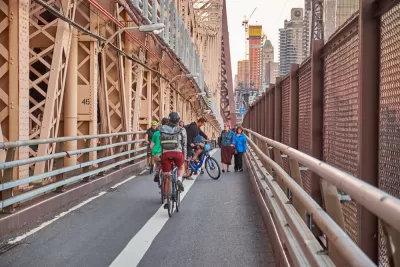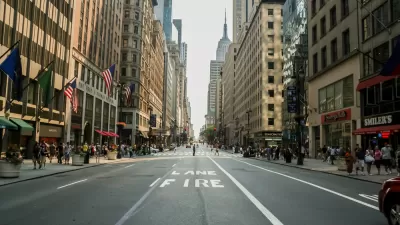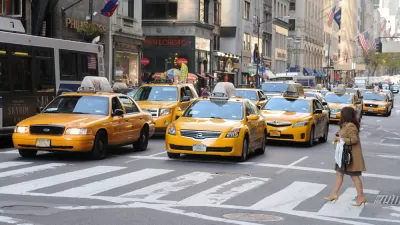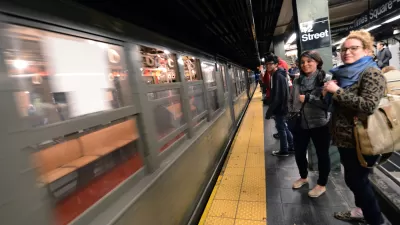New York State Budget Director Robert Mujica penned a Sunday op-ed for the Daily News on the benefits of congestion pricing. On Tuesday, Gov. Cuomo broke the news on WNYC that he and Mayor de Blasio agreed on tolling the central business district.

As posted Wednesday, congestion (or cordon) pricing in Manhattan below 61st Street took a huge step forward as point #2 in a "10-Point Plan to Restructure the MTA."
On Sunday, state Budget Director Robert Mujica explained how the plan came about, provided the latest Census data showing who will pay the variable tolls, which goes to the heart of the regressive aspect of tolling, and made the case for the legislature to approve the plan, ideally by April 1, according to the governor's interview on WNYC (see below).
"This year, Gov. Cuomo proposed in his executive budget a congestion pricing plan drawing on the input of the Metropolitan Transportation Sustainability Advisory Workgroup and Fix NYC advisory panel of transportation experts, representatives from the MTA region, local leaders and stakeholders," writes Mujica.
Out-of-state motorists expected to pay a plurality of cordon tolls
Let's be very clear: Not only is congestion pricing good for the environment and New Yorkers who use public transit, its impact on the region's car commuters is nowhere near as significant as some critics would like to claim.
According to U.S. Census data, far fewer New Yorkers commute into Manhattan by car than rely on public transportation. In fact, 25% of the commuters who would pay a congestion pricing fee are from out of state.
Meanwhile, a tiny percentage of residents in the surrounding boroughs and counties actually drive to work in Manhattan. In Suffolk County, it's 0.8% of residents. In Nassau, it's 1.8%. In Westchester, 2.2%; Staten Island, 2.3%; Bronx, 1.9%; Queens, 2.2%; and Brooklyn, 1.3%.
Tolling details
Actual details have yet to be released, such as the base toll, but Mujica explained that an "expert MTA oversight panel will set and approve variable pricing rates within the congestion pricing zone."
The tolls — which would take into account factors such as the type of vehicle, the time and day of the week, and credits from other bridges or tunnels — will then be implemented by [MTA's] Triborough Bridge and Tunnel Authority.
According to last year's Fix NYC Advisory Panel Report [pdf], passenger vehicles would pay a toll of $11.52 to drive south of 60th Street, charged once per day, Monday through Friday, between the hours of 6 am to 8 pm.
Tolling or 30 percent fare increase
"Without this critical new source of revenue, the MTA has acknowledged it would have to raise fares and tolls by almost 30% in the near future to cover capital costs," writes Mujica in the final paragraph.
WNYC discussion
Gov. Andrew Cuomo expounded on the relationship between auto tolls and transit fares along with many other aspects of the plan in a half-hour discussion with Brian Lehrer of WNYC on Wednesday morning. The governor provided a "rush transcript" for readers:
"The alternative to congestion pricing is really a fare increase," Cuomo tells Lehrer. "And it could be as high as 30 percent."
Cuomo explains that transit fares will continue to pay for New York City Transit Authority's operating expenses while motorists who pay the cordon tolls will help pay for the system's capital costs, which includes repairing the ailing subway as well as expansion.
Cuomo also elaborates on how Mayor Bill de Blasio, who never really supported cordon tolling and opted for a "millionaires' tax," came to change his mind. [Spoiler alert, blame (or credit) Trump.]
"I still believe a Millionaires Tax provides the best, most sustainable revenue source for the transit improvements our city needs," said the mayor in a separate statement. "But the time to act is running out, and among all alternatives, congestion pricing has the greatest prospects for immediate success."
Amazon HQ2
Lehrer also asked very insightful questions on Amazon's cancellation of its HQ2 plan for Long Island City. Cuomo offered a very impassioned defense of the proposal which would have brought the city and state $28 billion in new revenue in contrast to the much-maligned, record $3 billion incentive package the city and state offered the technology company.
Mujica's op-ed was reprinted on the governor's website.

Planetizen Federal Action Tracker
A weekly monitor of how Trump’s orders and actions are impacting planners and planning in America.

Congressman Proposes Bill to Rename DC Metro “Trump Train”
The Make Autorail Great Again Act would withhold federal funding to the system until the Washington Metropolitan Area Transit Authority (WMATA), rebrands as the Washington Metropolitan Authority for Greater Access (WMAGA).

DARTSpace Platform Streamlines Dallas TOD Application Process
The Dallas transit agency hopes a shorter permitting timeline will boost transit-oriented development around rail stations.

San Francisco's School District Spent $105M To Build Affordable Housing for Teachers — And That's Just the Beginning
SFUSD joins a growing list of school districts using their land holdings to address housing affordability challenges faced by their own employees.

Car-Centric LA Suburb Looks to a Train-Oriented Future
City leaders in Rancho Cucamonga, the future western terminus of the Brightline West rail line to Las Vegas, want to reimagine the city as a transit-oriented, pedestrian-friendly community.

New Alaska Bitcoin Mine Would Burn as Much Energy as the State’s Largest Coal Plant
Fueled by “stranded” natural gas, the startup hopes to become the largest in the US, and to make Alaska an industry center.
Urban Design for Planners 1: Software Tools
This six-course series explores essential urban design concepts using open source software and equips planners with the tools they need to participate fully in the urban design process.
Planning for Universal Design
Learn the tools for implementing Universal Design in planning regulations.
Municipality of Princeton
Roanoke Valley-Alleghany Regional Commission
City of Mt Shasta
City of Camden Redevelopment Agency
City of Astoria
Transportation Research & Education Center (TREC) at Portland State University
US High Speed Rail Association
City of Camden Redevelopment Agency
Municipality of Princeton (NJ)





























